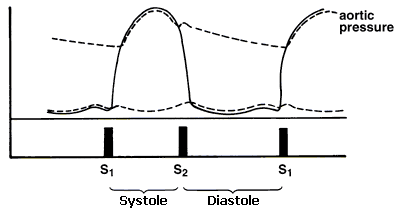Manuvers for Murmur Easy Way to Remember
Technique: Heart Sounds & Murmurs
Using the Stethoscope
A modern stethoscope consists of two earpieces connected by tubing to a chest piece which usually has both diaphragm and bell attachments. Earpieces should be angled forwards to match the direction of the practitioner's external auditory meati.The bell is used to hear low-pitched sounds. Use for mid-diastolic murmur of mitral stenosis or S3 in heart failure.
The diaphragm, by filtering out low-pitched sounds, highlights high-pitched sounds. Use for analyzing the second heart sound, ejection and midsystolic clicks and for the soft but high-pitched early diastolic murmur of aortic regurgitation.
back to top
Positioning the Patient
Patients can be examined while lying supine, in the left lateral decubitus position (see picture) and sitting, leaning forward. 
Pericardial sounds are sometime best heard with the patient on hands and knees.
back to top
Examination
1. Auscultate the heart at various sites
- At the apex.
- At the base (the part of the heart between the apex and the sternum)
- In the aortic and pulmonary areas to the right and left of the sternum, respectively
- The 1st heart sound, S1 (lub), marks the beginning of systole (end of systole).
- Related to the closure of the mitral and tricuspid valves.
- Loudest at the apex.
- The 2nd hear sound, S2 (dub), marks the end of systole (beginning of diastole).
- Related to the closure of the aortic and pulmonic valves.
- Loudest at the base.

You can relate the auscultatory findings to the cardiac cycle by simultaneously palpating the carotid artery while listening to the heart:
| S1 | S2 |
|---|---|
| Just precedes carotid pulse | Follows carotid pulse |
| Louder at apex | Louder at base |
| Lower pitch and longer than S2 | Higher pitch and shorter than S2 |
| Because systole is shorter than diastole: | |
| First of two grouped beats | Second of 2 grouped beats |
If anything abnormal is found, move the stethoscope around until the abnormality is heard most clearly.
2. Separate findings into six categories
- 1st & 2nd Heart Sounds
- 3rd & 4th Heart Sounds
- Clicks & Snaps
- Murmurs
- Rubs
- Maneuvers
3. Analyze each category individually and then put it together to diagnosis the problem
| Category | Definition | Audio examples |
|---|---|---|
| Aortic stenosis: | Murmur:
Possible associated findings:
| |
| Mitral Regurgitation: | Murmur:
Possible associated findings:
| |
| Aortic insufficiency: | Murmur:
Possible associated findings:
| |
| Tricuspid regurgitation: | Murmur:
Possible associated findings:
| |
| Pulmonic Insufficiency | Murmur:
Associated findings:
| |
| Pulmonary stenosis | Murmur:
Associated findings:
| |
| Mitral stenosis | Murmur:
Associated findings:
| |
| Hypertrophic cardiomyopathy | Murmur:
Possible associated findings:
|
Source: https://depts.washington.edu/physdx/heart/tech.html
0 Response to "Manuvers for Murmur Easy Way to Remember"
Post a Comment